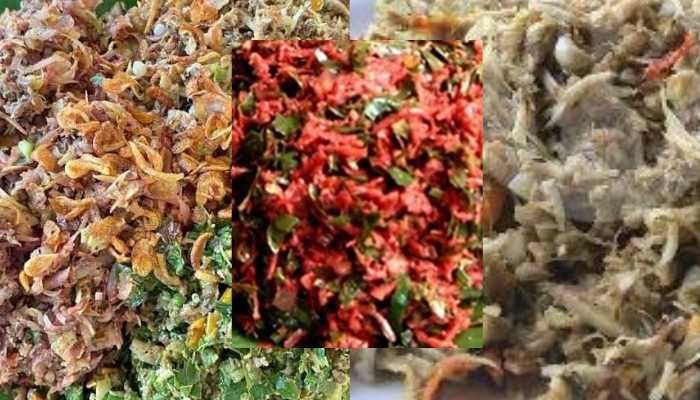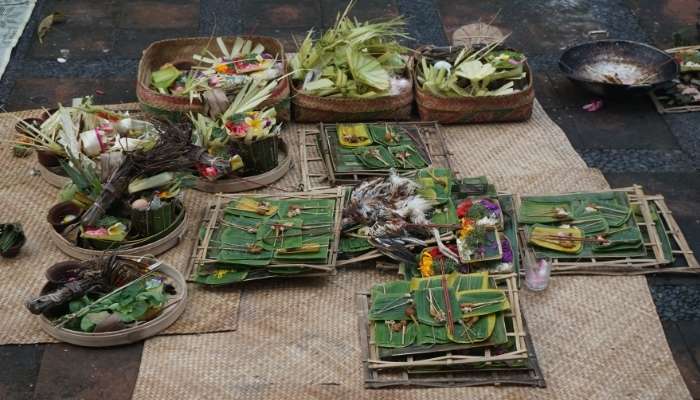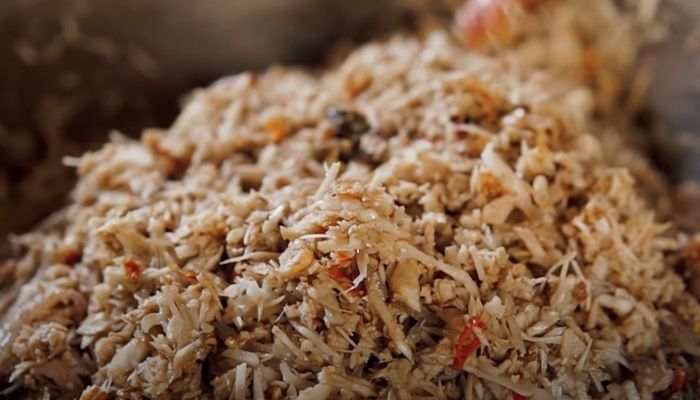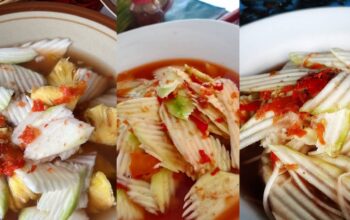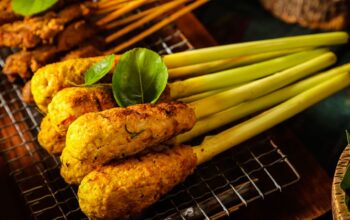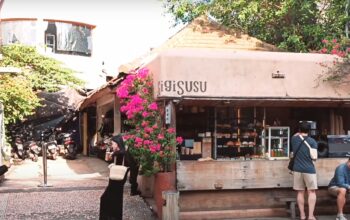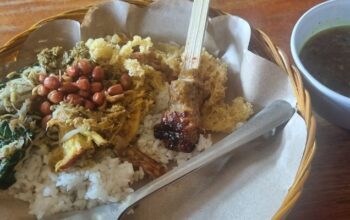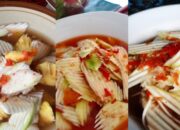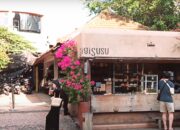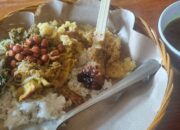Getting to Know Lawar Bali
Lawar is a traditional Balinese dish made from a mixture of meat (usually pork, chicken, or duck), grated coconut, a variety of vegetables, and base genep—a richly spiced Balinese seasoning blend. In some versions, animal blood is also added to enhance the flavor and symbolism.
Lawar can be categorized into several types based on its main ingredients, such as:
- Lawar Merah: Uses animal blood to give a distinctive color and flavor.
- Lawar Putih: Made without blood, often used in more sacred ceremonies.
- Lawar Nangka: Features young jackfruit as the primary ingredient.
- Lawar Kuwir: Made with duck meat.
- Lawar Klungah: Made with young coconut.
Lawar is typically served in large quantities to be enjoyed collectively by extended families or village communities during special events.
The History of Lawar Bali
Origins
Lawar is believed to have existed since the era of Ancient Bali. The name “lawar” comes from the Balinese word meaning “to finely chop,” referring to the method of cutting the ingredients for this dish. Originally, lawar was prepared within the context of traditional and religious ceremonies, reflecting the communal spirit and togetherness of Balinese society.
Development and Preservation
The tradition of mebat—a communal cooking activity before ceremonies—has played a key role in preserving the practice of making lawar. During mebat, men usually handle the meat and spices, while women prepare supporting ingredients. This process is not only a culinary activity but also a social and spiritual occasion that strengthens community bonds.
Today, despite the modernization of Balinese lifestyles, the tradition of making lawar persists. In fact, lawar remains a favorite menu item in many traditional Balinese eateries and restaurants.
The Role of Lawar in Balinese Society
In Religious Contexts
Lawar plays an important role in various Balinese Hindu ceremonies, such as Galungan, Kuningan, Ngaben (cremation ceremonies), and other Dewa Yadnya rituals. This dish often forms part of the banten (offerings) as a symbol of devotion to ancestors and deities.
The use of blood in lawar merah, for example, holds symbolic meaning as an offering to butakala (guardian spirits) or as a form of spiritual purification and revitalization.
As a Cultural Identity
Lawar has become a powerful symbol of Balinese cultural identity. Its presence at nearly every ceremony and celebration reflects the deep-rooted culinary traditions of Bali. It is more than just food—it is a statement of local pride and identity.
As a Social and Communal Medium
The collective preparation of lawar strengthens social ties within the community. The mebat tradition fosters cross-generational interaction and reinforces the values of mutual cooperation and family unity.
The Uniqueness of Lawar Bali
Base Genep Seasoning
One of lawar’s main unique features is the use of base genep, a traditional Balinese spice mix composed of galangal, ginger, turmeric, lesser galangal, shallots, garlic, chilies, shrimp paste, and various other spices. This blend produces a complex and distinctive flavor profile, balancing spiciness, savoriness, and a hint of sweetness.
Combination of Flavors and Textures
Lawar combines a variety of textures: the tenderness of meat, the crunchiness of fresh vegetables, and the savory taste of roasted grated coconut. The deeply absorbed spices enhance the dish’s overall flavor, making it even more enticing.
Regional Variations
Each region in Bali has its own version of lawar, such as:
- In North Bali, lawar tends to be spicier and uses more blood.
- In Karangasem, lawar nangka (young jackfruit lawar) is especially popular.
- In urban areas like Denpasar, chicken lawar is more common due to health and practicality considerations.
Freshness in Consumption
Lawar is made and consumed on the same day. Without preservatives, lawar spoils quickly and is not suitable for long-term storage. This makes lawar a “living dish,” symbolizing freshness and the ongoing cycle of life.
Gender Roles in Traditional Preparation
Interestingly, traditional lawar preparation reflects distinct gender roles. Men typically chop the meat and mix the blood (for lawar merah), while women prepare supporting ingredients. These roles contribute to the harmonious social structure of traditional Balinese communities.
Lawar in the Modern Era
In the Commercial Culinary Scene
Today, lawar is not only found at traditional ceremonies but also widely available in Balinese eateries, restaurants, and luxury hotels. Both locals and international tourists are drawn to its rich flavors and cultural significance.
Modern Innovations
Some chefs have adapted lawar for broader appeal, creating versions that use chicken without blood or vegan lawar with mushrooms replacing meat. These innovations address the needs of a wider market, including those with dietary restrictions.
In the Digital and Tourism World
With the rise of social media and the popularity of food photography, lawar has gained wider exposure. Many travelers and food bloggers share their experiences of tasting lawar in Bali, often accompanied by cultural stories, indirectly promoting Balinese tourism.
Conclusion
Lawar Bali is not merely a dish—it is a living cultural heritage deeply embedded in the daily life of Balinese people. It symbolizes social harmony, spirituality, and culinary richness. From household kitchens to five-star hotel tables, lawar continues to tell the enduring story of tradition, community, and identity.
Exploring lawar offers a deeper understanding of Bali: its flavors, its values, and its resilient culture. Thus, when visiting Bali, tasting lawar is not just a culinary experience but an authentic and profound cultural journey.
